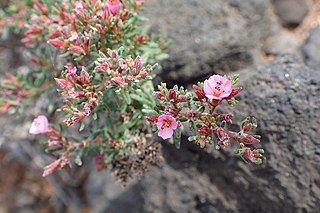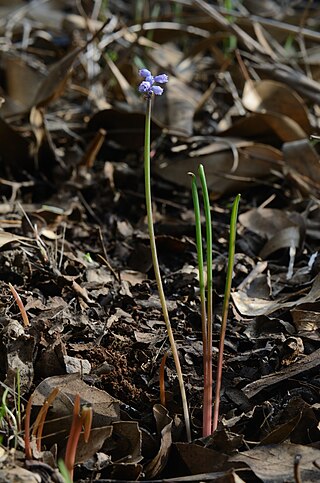
Lathyrus is a genus of flowering plants in the legume family Fabaceae, and contains approximately 160 species. Commonly known as peavines or vetchlings, they are native to temperate areas, with a breakdown of 52 species in Europe, 30 species in North America, 78 in Asia, 24 in tropical East Africa, and 24 in temperate South America. There are annual and perennial species which may be climbing or bushy. This genus has numerous sections, including Orobus, which was once a separate genus. The genus has numerous synonyms, including Pisum, the ancient Latin name for the pea.
Lathyrism is a condition caused by eating certain legumes of the genus Lathyrus. There are three types of lathyrism: neurolathyrism, osteolathyrism, and angiolathyrism, all of which are incurable, differing in their symptoms and in the body tissues affected.

Centaurium tenuiflorum, the slender centaury, is a species of annual herb in the family Gentianaceae. They have a self-supporting growth form and simple, broad leaves. Individuals can grow to 17 cm tall.
Crepis pusilla is a species of plants in the family Asteraceae.
Eleocharis ovata, the ovate spikerush, is a species of annual grass in the family Cyperaceae (sedges). They have a self-supporting growth form and have simple, broad leaves and green flowers. Individuals can grow to 1.5 feet.

Frankenia pulverulenta, the European seaheath, is a species of annual herb in the family Frankeniaceae. They have a self-supporting growth form and simple, broad leaves. Individuals can grow to 5 cm tall.

Hypecoum procumbens, the sickle-fruited hypecoum, is a species of annual herb in the family Papaveraceae. They have a self-supporting growth form and simple leaves. Individuals can grow to 40 cm tall.
Hypericum australe is a species of plant in the family Hypericaceae. Individuals can grow to 24 cm tall.

Lathyrus annuus, the annual vetchling, is a species of annual herb in the family Fabaceae. They are climbers and are associated with freshwater habitat. They have broad leaves. Individuals can grow to 37 cm tall.
Lathyrus gorgoni is a species of annual herb in the family Fabaceae. They have a self-supporting growth form and compound, broad leaves. Individuals can grow to 38 cm.

Lathyrus inconspicuus, the inconspicuous pea, is a species of annual herb in the family Fabaceae.

Lathyrus setifolius, the brown vetchling, is a species of annual herb in the family Fabaceae. They have a self-supporting growth form and compound, broad leaves. Individuals can grow to 31 cm.
Micromeria microphylla is a species of plants in the family Lamiaceae.

Misopates calycinum is a species of annual herb in the family Plantaginaceae. They have simple leaves.

Muscari parviflorum is a species of plants in the family Asparagaceae.

Parietaria lusitanica is a species of plant in the family Urticaceae.

Scorzonera laciniata, also known as cutleaf vipergrass, is a species of herb in the family Asteraceae.

Tamarix africana, also known as the African tamarisk, is a species of tree in the family Tamaricaceae. They have a self-supporting growth form and simple leaves. Individuals can grow to 6.3 m.

Trifolium lappaceum, the burdock clover, is a species of annual herb in the family Fabaceae. They have a self-supporting growth form and compound, broad leaves.

Trifolium suffocatum, the suffocated clover, is a species of annual herb in the family Fabaceae. They have a self-supporting growth form and compound, broad leaves. Individuals can grow to 4.2 cm.














